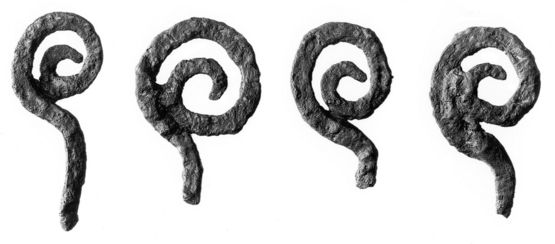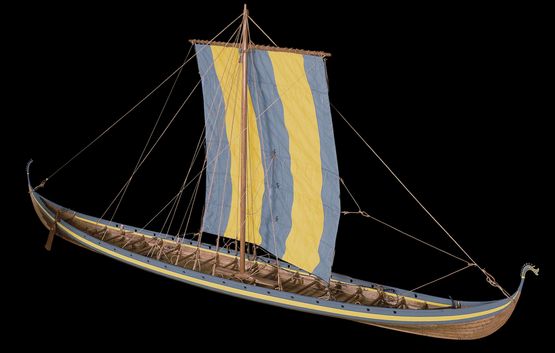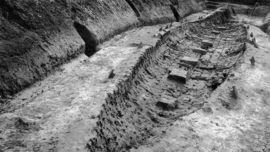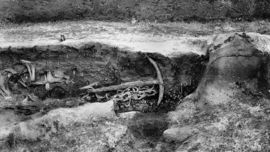The Ladby ship
The Ladby ship was discovered on Funen in 1934 and it was excavated in the two subsequent years. It had not sunk or been wrecked, but was found below a burial mound high in the terrain looking out over Kertinge Nor. All the woodwork in the vessel had rotted away, but the many iron rivets, which had held the ship’s planks together, still lay in place. On the basis of their distribution, and with the aid of traces of the rotten wood, it has been possible to reconstruct the original form and construction of the ship.
The ship had a length of rather more than 21.5 m and was almost 3 m wide amidships. At the same point it measured just over 1 m from the lower surface of the keel to the top of the gunwale. It was equipped with 15-16 pairs of oars. Iron rings, attached to the sides of the ship amidships, show that the ship carried both mast and sail.
The construction of the ship corresponds to that seen in other examples of Scandinavian longships. The stem and stern were curved and had been carved with a stepped inner surface, which provided a bedding for the planks of the hull. These comprised, at least partially, of oak wood and were 2-2.5 cm thick. One strake was significantly thicker and narrower than the others. This acted as a meginhufr, a "strengthening plank" which formed the transition between the bottom and the sides of the hull. Further up, the ship’s sides had been reinforced with stringers, long, robust wooden strips affixed to the inner surface of the upper edge of a strake.
The ribs, which were responsible for the transverse bracing of the ship, were secured to the planks with treenails. The ribs were placed rather more that 90 cm apart so that the oarsmen, who sat on the thwarts above the ribs, had plenty of room to work the oars.
As the wood from the ship had rotted away, it was not possible to date the ship with the aid of dendrochronology, which is the normal method of dating archaeological finds of ships. However, the preserved grave goods date from the first part of the 10th century. As the ship had clearly been used for a while before it was incorporated into the burial – traces were found of several minor repairs – it is therefore likely that the ship itself was built around AD 900.
Among the ship's equipment, which was found together with the Ladby ship, special mention should be made of the 1.26 m high anchor of Norwegian iron. The anchor was equipped with an 11 m long anchor chain. This need not necessarily have extended all the way from anchor to ship, but in deeper water it ensured that the lower end of the anchor rope was drawn down onto the sea bed. This reduced the risk of the anchor being torn loose unintentionally. Two swivels, inserted into the anchor chain, prevented the chain from kinking if the ship, driven by wind or current were to twist the anchor chain. While there are other finds of anchors from the Viking Age, the anchor chain is, so far, unique.
Another unusual find from the Ladby ship comprised a row of small iron spirals, which were found at the bow, and an iron band with spikes attached found at the stern. These are perceived as decorations on the top of the stem and stern, probably shaped respectively as a dragon's head and tail.
Danish text: Jan Bill
Translation: Gillian Fellows-Jensen

Archaeological findings of longships
Learn more about the longships we know today. Some were found in burial mounds, others in the Viking's harbours and others were recycled by the Vikings as part of defense systems of their main towns.
Below you can find links to read more about the longships.
» Ladby - the ship in the grave
» The longship from Haithabu Harbour


